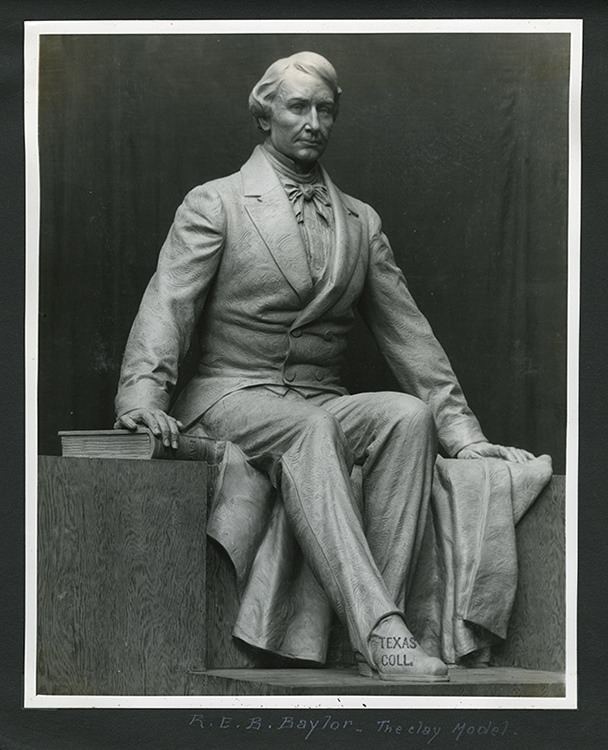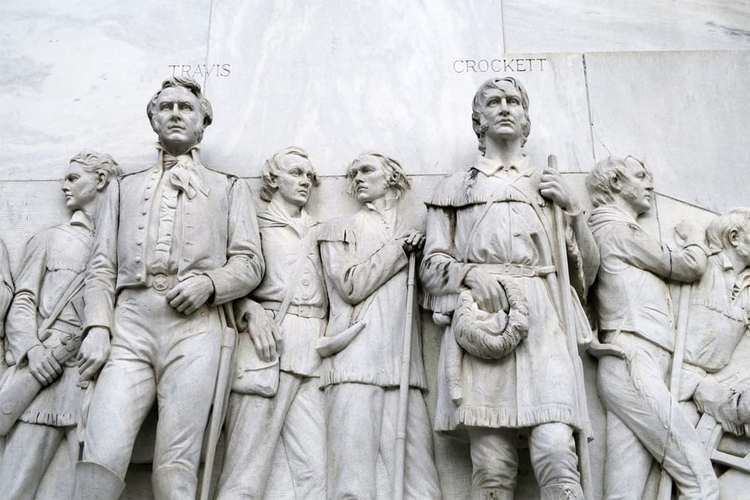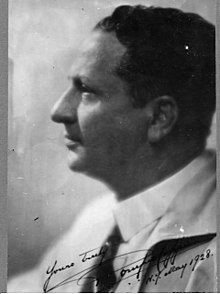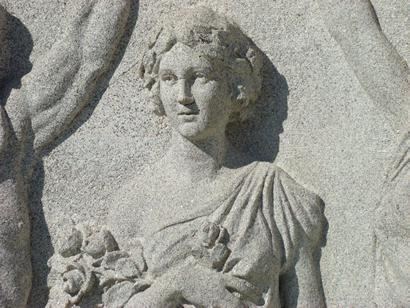Website Coppini Academy Name Pompeo Coppini | Books From Dawn to Sunset | |
 | ||
Full Name Pompeo Luigo Coppini Nationality Italian born1902 Naturalized AmericanUnited States citizen Notable work Partial listing - Sculptures, except where notedItalyThe King Humbert Tablet, Royal Museum, MonzaMexicoMexico CityBust of President Porfirio DiazGeorge Washington MonumentKentucky1911 John Hunt Morgan Memorial, LexingtonMichigan1925 John Ball and Children, Grand RapidsNew JerseyNeptune Fountain, Orphan Asylum, CarneyNew York1900 William McKinley1930 Spirit of the Rotary1931 150th Anniversary Masonic Grand Lodge Plaque, Utica1934 Bust of Dr. John Robert Gregg1935 Woodrow Wilson1933 Memorial to Benjamin Franklin, John Adams and Edward Rutledge, Statten Island1941 George B. CortelyouTexas1934 Texas Centennial Half DollarAustin1901 Texas Confederate Monument, Capitol Grounds1903 Victims of the Galveston Flood, UT campus1907 Terry’s Texas Rangers, Capitol Grounds1910 Hood's Brigade, Capitol Grounds1912 Stephen F. Austin, Texas State Cemetery1915 Joanna Troutman-Designer of the Texas Flag,Texas State Cemetery1933 Littlefield Fountain and free-standing statues, UT campus:Jefferson DavisRobert E. LeeJames HoggAlbert Sidney JohnstonJohn H. ReaganWoodrow Wilson1955 George Washington, University of TexasBallinger1919 Charles H. Noyes, Courthouse lawnBeaumont1912 George O’Brien Millard, Pipkin ParkCameron1922 Mr. and Mrs C.H. YOECollege Station1919 Lawrence Sullivan Ross, TAMU CampusCorpus Christi1914 Queen of the SeaDallas1936 Prospero Bernardi, Fair ParkGalveston1904 Woodmen of the World, Lakeview CemeteryGonzales1910 Come and Take It!Huntsville1911 Sam Houston Memorial, Oakwood CemeteryMcKinney1911 James W. Throckmorton, McKinney Courthouse LawnPalestine1911 John H. Reagan MemorialParis1903 Confederate MonumentSan Antonio1926 Scottish Rite Cathedral doors1929 Enlightening of the Press, Entrance of the San Antonio Express Publishing Company1939 Spirit of Sacrifice (aka The Cenotaph), Alamo Plaza1946 Genius of Music (w Waldine Tauch), Brackenridge Park1953 Coppini Memorial Sunset Memorial Park (Coppini’s gravesite),1972 George Washington Brackenridge (sculpted by Coppini 1930's, cast by Waldine Tauch, bureaucratic red tape delayed installation until 1972)Winn Family Gravesite, City Cemetery #1Shiner1919 Julius A. WoltersVictoria1912 Firing Line, DeLeon Plaza and BandstandWaco1905 Burleson Memorial, Baylor Campus1938 R.E.B. Baylor, Baylor Campus Education Accademia di Belle Arti di Firenze People also search for George W. Littlefield, Mildred Terrell Satterwhite White Littlefield, Fleming Littlefield | ||
Pompeo Luigi Coppini (May 19, 1870 – September 26, 1957) was an Italian born sculptor who emigrated to the United States. Although his works can be found in Italy, Mexico and a number of American states, the majority of his work can be found in Texas. He is particularly famous for the Alamo Plaza work "Spirit of Sacrifice" a.k.a. The Alamo Cenotaph, as well as numerous statues honoring Texas heroes.
Contents

Early years

He was born in Moglia, Mantua, Italy, the son of musician Giovanni Coppini and his wife Leandra (Raffa) Coppini.

The family moved to Florence where at the age of ten, Pompeo was hired to make ceramic horses shaped like whistles. From there, he worked for a sculptor who made tourist knock-offs of great works of art. At age sixteen, he studied at Accademia dell'Arte del Disegno under Augusto Rivalta. Upon earning a degree, Coppini opened a short-lived studio making gratis busts of local celebrities. While working for a cemetery monument sculptor, Coppini tried to become co-owner of the business by courting the owner's daughter. The girl's mother balked, and the resulting situation got Coppini denounced from a local priest's pulpit.
The United States

He emigrated to the United States in March, 1896 with nothing but a trunk of clothes and $40 to his name. Coppini got a job in New York sculpting figures for a wax museum. Elizabeth di Barbieri of New Haven, Connecticut arrived, accompanied by a chaperone, to model for Coppini's memorial to Francis Scott Key. He fell in love and married his model. Coppini became a United States citizen in 1902.
While he managed to find work in New York, Coppini was frustrated the fame and greatness escaped him. He moved to Texas in 1901, to join with German-born sculptor Frank Teich. He was then commissioned to do the figures for the Confederate monument for the state capitol grounds. For the next fifteen years, he lived and worked in San Antonio. After spending a short time in Chicago, Illinois, he then spent three years in New York City overseeing the Littlefield commission for the University of Texas at Austin. He collaborated with architect Paul Cret on the Littlefield Memorial Fountain, and sculpted six statues for the campus.
By 1910, Coppini was assisted by sculptor Waldine Tauch, who had been born in Schulenburg, Texas. Tauch became more-or-less his adopted daughter, student and protégée, and he, after extracting a promise from her that she would never marry, molded her into a devotee of classical sculpture. She collaborated with Coppini until his death.
The William P. Rogers chapter of the United Daughters of the Confederacy raised $5,000 in 1911 and commissioned Coppini to design and erect the 1912 Confederate soldier memorial statue named "Last Stand", a.k.a. "Firing Line", in De Leon Plaza, Hiring Otto Zirkel of near the San Antonio studio to build the stone portion of the monument.
He sculpted three distinct statues of George Washington. The first, commissioned by Americans living in Mexico to commemorate the 1910 centennial of Mexican Independence, was installed in 1912 in the Plaza Dinamarca (renamed Plaza Washington) of the Colonia Juárez section of Mexico City. The Mexican Civil War was just beginning. Two years later, in reaction to the April 1914 United States invasion of Veracruz, the statue was toppled from its pedestal and dragged through the streets. The second statue was created to commemorate the 1926 sesquicentennial of the Declaration of Independence. It was installed in 1927 in Portland, Oregon. The third statue was commissioned by the Texas Society, Daughters of the American Revolution to commemorate the 1932 bicentennial of Washington's birth. Fund-raising problems delayed the project for years, and it was installed in February 1955 on the campus of the University of Texas at Austin.
In 1931, Italy decorated Coppini with the Commendatore of the Order of the Crown of Italy for his contribution to art in America. The Texas Centennial Committee awarded Coppini the 1934 commission to design the Texas Centennial Half Dollar. In 1937, Coppini opened his San Antonio studio on Melrose Place, in order to work on what would become the Spirit of Sacrifice (a.k.a. The Cenotaph) at Alamo Plaza. Baylor University awarded Coppini an honorary doctor of fine arts degree in 1941. From 1943 to 1945 he was head of the art department of Trinity University in San Antonio. In 1945 he and Tauch cofounded the Classic Arts Fraternity in San Antonio (renamed Coppini Academy of Fine Arts in 1950).
Many of his works are in Austin, Texas, displayed on the grounds of the Texas State Capitol and on the campus of The University of Texas. Coppini's statue of Lawrence Sullivan Ross, Texas Governor and third president of Texas A&M University is considered one of the most revered works on the A&M campus in College Station and students often place coins at the statue's feet for good luck on exams. Coppini's marble statue of Senator James Paul Clarke stands in the U.S. Capitol. Coppini also designed two bronze sculptures at Baylor University in Waco, Texas—those of former Baylor University President Rufus C. Burleson, located on the Burleson Quadrangle on the Baylor campus (1905), and Baylor University namesake and founder Judge R.E.B. Baylor (1939). One of Coppini's best works, as stated by the artist, is the bronze sculpture of John Reagan, former U.S. Senator from Palestine, Texas, located in that city's Reagan Park (1911), featuring the personification of the "Lost Cause of the Confederacy" seated at the base of the monument.
Coppini died in San Antonio on September 26, 1957. He designed his own crypt for his final resting place in Sunset Memorial Park.
